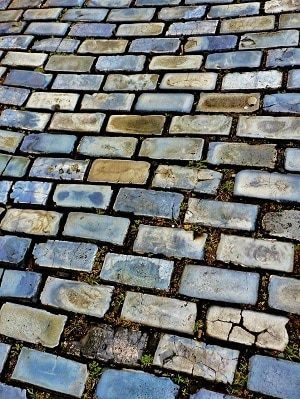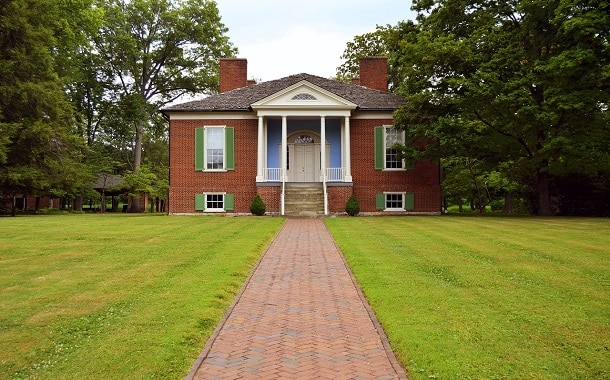How Much Does a Brick Walkway Cost?
Last Updated on February 4, 2024
Written by CPA Alec Pow | Content Reviewed by ![]() CFA Alexander Popinker
CFA Alexander Popinker
Installing a brick walkway can greatly enhance the aesthetic appeal and functionality of your outdoor space. But before taking on this landscaping project, it’s important to understand the costs involved.
This guide will break down the key factors that influence brick walkway pricing so you can budget and plan for a beautiful new pathway.
A brick walkway offers charm and durability, making it a worthwhile investment for your home. Pavers stand up well to heavy foot traffic while providing visual interest and complementing landscaping features. When professionally installed, a brick path can last for decades with proper care.
But how much will it cost to build that dream walkway? The price per square foot can range quite a bit based on the materials, design, and labor expenses involved.
How Much Does a Brick Walkway Cost?
On average, expect to pay $10-$25 per square foot for a basic brick walkway. Small and straightforward DIY projects may cost as little as $5 per square foot. More intricate designs with high-end pavers and professional installation can cost $25-50+ per square foot.
For a medium-sized walkway of about 200 square feet, you may spend $2,000-5,000 in total. Always get a detailed quote for your specific project since prices vary.
Homewyse gives the following numbers for the cost of building a brick paver walkway:
- Material: $368.27 – $520.00
- Labor costs: $368.27 – $520.00
- Total (for 220 square feet): $368.27 – $520.00
Kitchen and Residential Design writes that the cost of professional installation is up to $18 per square foot, bringing the total cost of a typical walkway to about $3,600.
According to HomeGuide, homeowners should expect brick prices of $0.35 – $0.90 each for face, engineer, or red bricks, while brick installation costs $5 to $13 per square foot for materials and labor.
Cost Elements for Brick Walkways
The main elements that make up the total cost of a brick walkway include:
- Bricks: $2-10 per square foot
- Installation labor: $5-15 per square foot
- Base preparation: $1-3 per square foot
- Excavation and grading: $1-4 per square foot
- Landscaping around walkway: $5-15 per square foot
Additional potential expenses include permitting, site plans, and special features like lighting or railings. Expect to spend $15-30 per square foot when using expensive brick types and hiring a professional for the full installation. Simple DIY projects with basic materials can cost as little as $5-8 per square foot.
For a 200-square-foot walkway, you may spend:
- DIY with basic bricks: $1,000-$1,600
- Professionally installed with upgraded pavers: $3,000-$6,000
Always get an itemized quote from contractors to understand exactly what is included in your project budget. Be sure to account for the specific bricks, design elements, preparation work, and labor required.
Factors That Impact Cost
Several important considerations affect the overall price of installing a new brick walkway:
Brick Type and Quality
The quality and source of the bricks make a big difference in cost. Handmade clay bricks tend to be the most expensive, costing $5-15 per square foot. While beautiful, these pavers require specialized masonry skills to install.
Concrete pavers offer the look of clay bricks at a lower price point, ranging from $2-5 per square foot. High-quality concrete bricks can last decades.
Salvaged bricks can sometimes be found at reduced costs but may have irregular shapes and require more prep work.
Design Complexity
Simple straight or gently curving paths tend to be the most affordable brick walkway designs. Complex patterns, custom shapes, special borders and accents will increase labor time and expenses.
Incorporating steps, lighting, or decorative elements also adds to the project pricing. The more intricate the layout, the more you can expect to pay.
Professional vs. DIY Installation
Hiring a professional landscape contractor to install your brick walkway generally costs $5-15 per square foot for labor. If you’re reasonably handy, you can save significantly by doing it yourself. But DIY installation does require an investment of your own time and physical work.
Excavation and Grading
Any grading, digging out topsoil, leveling the ground, and implementing drainage for the walkway adds additional costs, which could range from $1-4 per square foot. Proper excavation and base preparation creates a solid foundation for a long-lasting pathway.
Special Permits
If your project requires an architectural permit from the city or town to approve the plans, this will add permitting fees to the total cost. Permits are usually required if the walkway is over a certain square footage.
Planning and Design Considerations
Carefully planning out your brick walkway will help optimize the investment value and visual appeal. Here are key factors to weigh when choosing materials and layout:
Brick Type
Consider the climate in your region and how much foot traffic the bricks will receive. Clay pavers offer unmatched charm but require more care. Concrete alternatives provide long-term durability with less maintenance.
Walkway Width
Standard walkways are 3-5 feet wide, allowing two people to pass through comfortably or move small furniture and yard tools. Wide paths spanning 6 feet or more make a bold statement but use more materials.
You might also like our articles about the cost of a brick mailbox, block foundation repair, and wood retaining wall installation.
Placement
Link your new walkway to existing outdoor living spaces and your home’s entries and exits while complementing the landscape design.
Layout
 Simple, straight walkway designs keep costs down while allowing the brick textures to shine. Incorporate gradual curves or borders to add interest. Complex patterns and shapes add labor and expenses.
Simple, straight walkway designs keep costs down while allowing the brick textures to shine. Incorporate gradual curves or borders to add interest. Complex patterns and shapes add labor and expenses.
Excavation
Excavating 4-6 inches down and creating a gravel base prevents shifting and buckling while promoting drainage.
Complementary Elements
Consider adding lighting, benches or an arbor to create an inviting ambiance while tying the walkway into the overall landscape.
How to Install a Brick Walkway
Once you’ve selected materials and have a site plan, here are the key steps for proper installation:
- Mark the layout and dig out sod within the area, excavating 4-6 inches down.
- Compact soil and add 2-4 inches of gravel, leveling with a rake.
- Set the edge restraints that will hold the pavers in place. Use stakes and string to guide layout.
- Spread 1-2 inches of sand within restraints. Smooth and level with rake.
- Set the first row of bricks against the edge restraints. Use string lines to keep straight.
- Fill the gaps between bricks with sand. Tamp down with hand tamper.
- Complete additional rows, using spacers to keep even gaps between bricks.
- Tamp periodically to settle pavers into the sand bedding and flatten all rows.
- Sweep and vibrate sand into gaps until filled. Spray off residue.
- Do a final inspection of the bricks, adjusting any unevenness with sand under bricks.
Take time to properly prepare the base and keep pavers level with sand bedding for best results. Avoid overly tight spacing between bricks which could lead to buckling.
Maintenance and Durability
A properly installed brick walkway can easily last 20-40 years. Follow these tips for longevity:
- Prevent buckling by keeping gaps filled with sand to allow drainage.
- Weed control using sprays or by hand pulling prevents damage between bricks.
- Power wash annually to prevent staining and debris buildup.
- Seal bricks every 1-2 years to prevent fading and improve stain resistance.
- Fill cracks with sand or bricks may gradually settle and shift.
- Replace broken bricks as needed to prevent tripping hazards.
With regular maintenance, an attractive brick walkway will enhance your landscape for decades to come.
Cost-Saving Tips for Brick Walkways
Follow these suggestions to get the most value from your project budget:
- Shop end of season sales to get discounted bricks.
- Opt for concrete pavers rather than pricier clay bricks.
- Choose a simple straight or gently curving pattern over intricate designs.
- Do as much DIY preparation and labor-intensive work yourself as possible.
- Get quotes from 3-4 contractors to compare pricing.
- Consider salvaged or used bricks to save on materials.
- space bricks closely without mortar joints to use fewer supplies.
- Stick to a smaller pathway for fewer overall bricks.
Conclusion
Investing in a professionally installed brick walkway usually ranges from $15-30 per square foot, with the average DIY project costing $8-15 per square foot.
Factors like brick type, complexity, excavation needs, and labor approach significantly impact the total expense. With some savvy planning and cost-conscious choices, you can install an attractive new pathway that won’t break the bank.
Just be sure to leave room in your budget for long-term maintenance to maximize durability. Enjoy your updated landscape for decades to come!
FAQs: Brick Walkway Installation
How do you make a simple brick walkway?
For a basic DIY walkway, excavate 4-6 inches down and add crushed gravel for drainage. Set edge restraints and level 2 inches of sand. Lay the pavers tightly together without mortar joints and fill gaps with sand once all bricks are set.
Sweep off residue and tamp down the pathway once all bricks are set for stability. Keep bricks tight together without mortar for a clean, simple look.
How wide should a brick walkway be?
The standard width for a brick walkway is 3-5 feet, allowing two people to pass through comfortably. Wider walkways of 6 feet or more make more of a statement but require purchasing substantially more materials. Measure existing walkways you find appealing for a sense of appropriate proportions for your property.
Can you lay brick directly on concrete?
It’s not recommended to lay brick pavers directly onto a concrete slab, as it needs a bedding layer of sand at minimum to allow for leveling the bricks and drainage.
Screed a 1-2 inch layer of sand over the cured concrete, tamp it down to make even, and lay bricks on top of the smoothed sand bed. This allows bricks to be properly leveled and remain stable.


Leave a Reply
Want to join the discussion?Feel free to contribute!